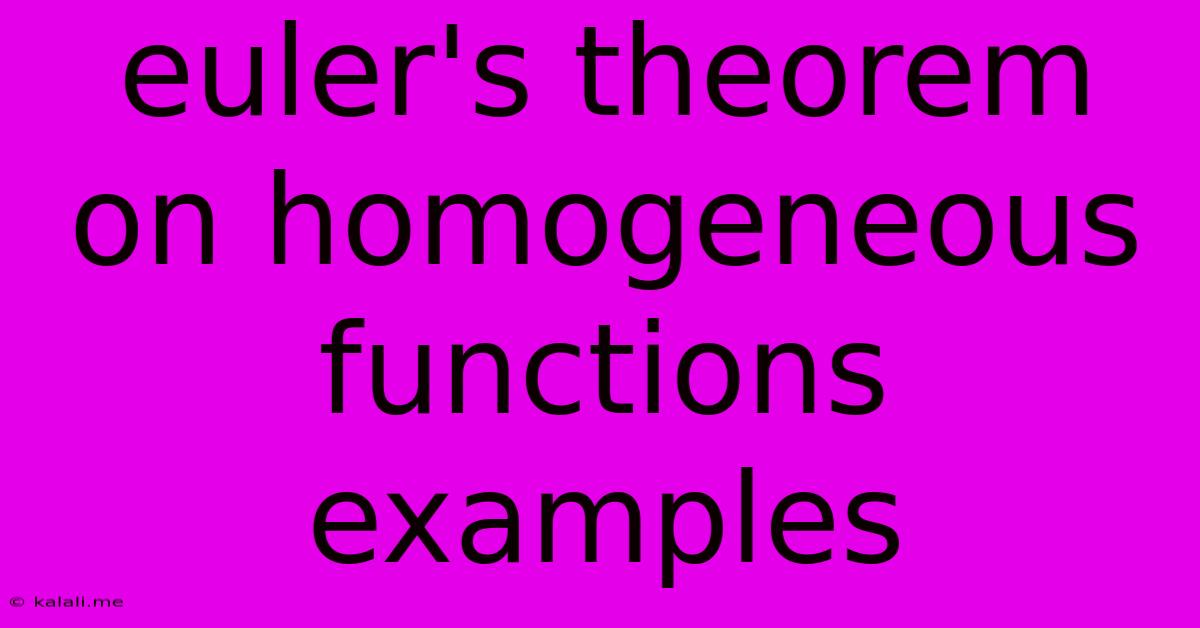Euler's Theorem On Homogeneous Functions Examples
Kalali
Jun 14, 2025 · 3 min read

Table of Contents
Euler's Theorem on Homogeneous Functions: Examples and Applications
Euler's theorem is a fundamental result in multivariable calculus, providing a powerful connection between homogeneous functions and their partial derivatives. Understanding this theorem is crucial for various applications in economics, physics, and engineering. This article will delve into Euler's theorem, exploring its statement, proof (for a simple case), and illustrating its application with several examples. We'll also touch upon its significance and broader implications.
What is a Homogeneous Function?
Before diving into Euler's theorem, we need to define a homogeneous function. A function f(x₁, x₂, ..., xₙ) of n variables is said to be homogeneous of degree k if it satisfies the following condition:
f(tx₁, tx₂, ..., txₙ) = tᵏf(x₁, x₂, ..., xₙ) for all t > 0
This means scaling all the input variables by a factor 't' scales the output by a factor of tᵏ. For example, a homogeneous function of degree 1 is often called a linear homogeneous function.
Euler's Homogeneous Function Theorem
Euler's theorem states that if f(x₁, x₂, ..., xₙ) is a homogeneous function of degree k, then:
x₁∂f/∂x₁ + x₂∂f/∂x₂ + ... + xₙ∂f/∂xₙ = kf(x₁, x₂, ..., xₙ)
This equation beautifully connects the function's value to a weighted sum of its partial derivatives. Each term xᵢ∂f/∂xᵢ represents the contribution of the i-th variable to the total value.
Proof (for a function of two variables):
Let's consider a simple case: a homogeneous function f(x, y) of degree k. By definition:
f(tx, ty) = tᵏf(x, y)
Now, differentiate both sides with respect to t:
∂/∂t [f(tx, ty)] = ∂/∂t [tᵏf(x, y)]
Using the chain rule on the left side and simple differentiation on the right:
x∂f/∂(tx) + y∂f/∂(ty) = ktᵏ⁻¹f(x, y)
Now, set t = 1:
x∂f/∂x + y∂f/∂y = kf(x, y)
This demonstrates Euler's theorem for a function of two variables. A similar approach, though more notationally complex, can be used to prove the theorem for n variables.
Examples of Euler's Theorem in Action:
Let's illustrate Euler's theorem with some examples:
Example 1: A Simple Polynomial
Consider the function f(x, y) = x² + 3xy + y². This is a homogeneous function of degree 2.
- ∂f/∂x = 2x + 3y
- ∂f/∂y = 3x + 2y
Applying Euler's theorem:
x(2x + 3y) + y(3x + 2y) = 2x² + 3xy + 3xy + 2y² = 2(x² + 3xy + y²) = 2f(x, y)
The theorem holds true.
Example 2: Cobb-Douglas Production Function
The Cobb-Douglas function, often used in economics, is a homogeneous function: f(x, y) = Axᵃyᵇ, where A, a, and b are constants. This function has a degree of homogeneity equal to a + b. You can verify this by applying Euler's theorem and observing the result.
Example 3: A Function of Three Variables
Consider f(x, y, z) = x³ + 2xyz + z³. This is homogeneous of degree 3. Calculating the partial derivatives and applying Euler's theorem will confirm the relationship.
Conclusion:
Euler's theorem on homogeneous functions is a significant result with far-reaching consequences. Its applications extend beyond simple mathematical exercises, providing valuable insights into various fields. Understanding this theorem empowers us to analyze and solve problems involving homogeneous functions efficiently, particularly in areas like optimization and economic modeling. By grasping the fundamental concepts and working through examples, one can develop a deeper appreciation for the elegance and power of this theorem.
Latest Posts
Latest Posts
-
Compare And Contrast Direct Democracy And Representative Democracy
Jun 14, 2025
-
Temperature At Which A Solid Becomes A Liquid
Jun 14, 2025
-
What Is The Outer Boundary Of A Cell
Jun 14, 2025
-
Which Of The Following Statements Is True Of Weld Grooves
Jun 14, 2025
-
Atmospheric Layer Closest To The Earth
Jun 14, 2025
Related Post
Thank you for visiting our website which covers about Euler's Theorem On Homogeneous Functions Examples . We hope the information provided has been useful to you. Feel free to contact us if you have any questions or need further assistance. See you next time and don't miss to bookmark.